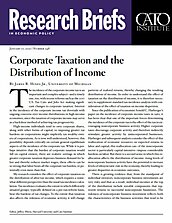The incidence of the corporate income tax is an important and complex subject—and a timely one, too, with recent reforms such as the 2017 U.S. Tax Cuts and Jobs Act making significant changes to corporate taxation. Interest in the incidence of the corporate income tax dovetails with ongoing concerns over income distributions in high-income economies, since the taxation of corporate income may serve as a backdoor method of achieving tax progressivity.
High-income individuals tend to own corporate shares, along with other forms of capital, so imposing greater tax burdens on corporations might implicitly tax wealthy owners of corporations. As is now well understood, however, this possibility depends critically on certain general equilibrium aspects of the incidence of the corporate tax. While it is perhaps intuitive that the burden of corporate taxation would fall on capital owners, there are realistic settings in which greater corporate taxation depresses business demand for labor and thereby reduces market wages; these effects can be so strong that labor bears all the corporate tax burden, or potentially even more than that.
My research considers the effect of corporate taxation on the distribution of after-tax income, which requires a somewhat different perspective than the usual tax-incidence calculation. Tax incidence evaluates the extent to which differently situated groups, typically defined on a pre-tax-reform basis, bear the burdens of tax changes. To the extent that taxation also affects the riskiness of economic activity, it will change patterns of realized returns, thereby changing the resulting distribution of income. In order to understand the effect of taxation on the distribution of income, it is therefore necessary to supplement standard tax-incidence analysis with consideration of the effect of taxation on income dispersion. Since the publication of economist Arnold C. Harberger’s paper on the incidence of corporate income taxes in 1962, it has been clear that one of the important forces determining the incidence of the corporate tax is the effect of the tax in encouraging noncorporate business activity. Higher corporate taxes discourage corporate activity and therefore indirectly stimulate greater activity by unincorporated businesses. Harberger and subsequent analysts consider the effect of this reallocation of economic resources on expected returns to labor and capital; this reallocation can—if the noncorporate sector is particularly capital-intensive—impose considerable burdens on labor. But there is a second sense in which this reallocation affects the distribution of income: rising levels of noncorporate business activity have the potential to increase levels of idiosyncratic risk in the economy, thereby leading to greater disparities in economic outcomes.
There is growing evidence that, from the standpoint of individual investors, noncorporate business investments are very risky and that as a result, individual incomes at the top of the distribution include sizeable components that represent returns to successful noncorporate businesses. The riskiness of noncorporate business investment reflects both the characteristics of the business activities that tend to be undertaken by unincorporated firms and the nature of their ownership. U.S. investors in unincorporated business ventures generally incur much greater idiosyncratic risk than do investors in publicly traded corporations. Proprietorships have single owners. Partnerships, including limited liability corporations (LLCs), must specify their owners in partnership agreements, making it difficult to have diversified ownership and costly and cumbersome to change ownership shares at all. S corporations must have 100 or fewer shareholders, and all shareholders must be U.S. citizens or permanent residents and must hold stock with equal rights. In practice, high-income individuals commonly receive partnership and S corporation income from firms of which they are the sole owners. C corporations, whose income is subject to the corporate tax, suffer from none of these restrictions and, as a result, can much more easily have diversified ownership. Because of the undiversified ownership of unincorporated businesses, the returns received by their owners can be very risky, quite apart from the undoubtedly larger business risks that these smaller businesses tend to face.
The consequences of the risky profile of noncorporate investment are predictable: some noncorporate business owners are very successful, whereas others lose significant portions of their investments. Investors in unincorporated businesses can face return distributions similar to those available by playing lotteries, and with more lotteries, the economy’s income distribution widens.
Higher levels of corporate taxation change the composition of economic activity both by encouraging entrepreneurs to establish their firms as unincorporated businesses and—more importantly—by reducing the size and growth of corporations, thereby causing noncorporate businesses to expand. This reallocation of economic activity represents substitution away from relatively safer economic forms and styles of business organization into those that offer high returns to some and low returns to others.
As a consequence, there will be greater numbers of entrepreneurs who are highly successful and join the ranks of the rich, just as there will be greater numbers of unsuccessful businesspeople. The result is to make the distribution of income less equal—and evidence from the United States for 2014–2017 suggests that this process may reverse at least half the distributional effect of the corporate tax that arises from reducing average capital returns.
NOTE:
This research brief is based on James R. Hines Jr., “Corporate Taxation and the Distribution of Income,” NBER Working Paper no. 27939, October 2020, http://doi.org/10.3386/w27939.
About the Author
James R. Hines Jr., University of Michigan

This work is licensed under a Creative Commons Attribution-NonCommercial-ShareAlike 4.0 International License.
